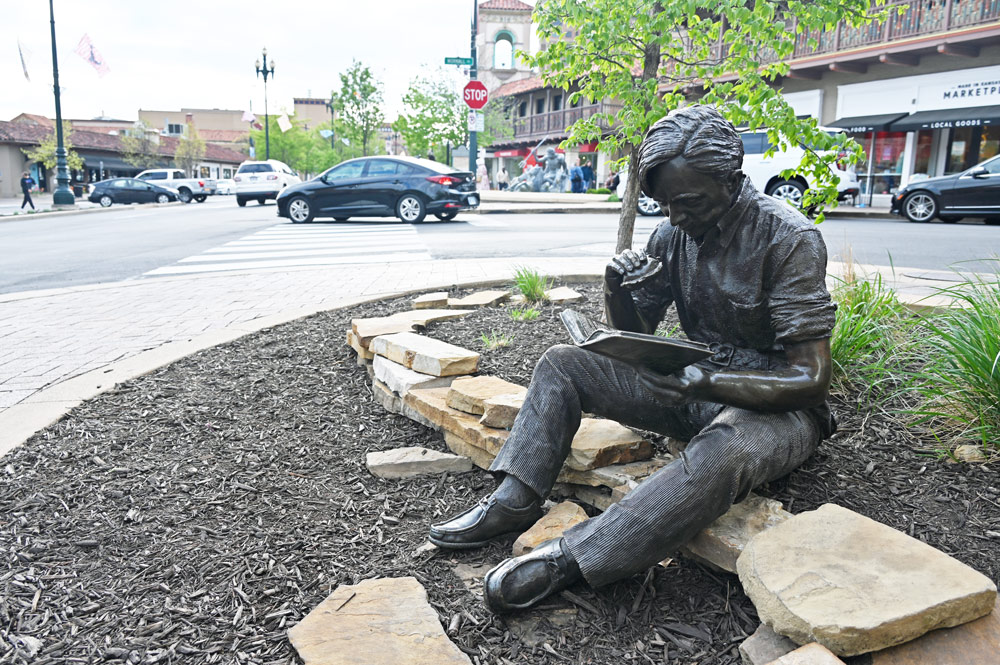
When I invited County Judge Andrea Totten to participate in this year’s edition of our local leaders’ favorite reads of the year, we ended up having a couple of exchanges by email about her choice–David Copperfield. It’s a wonder the judge didn’t sign my arrest warrant after what I told her about Dickens, and how.
For all sorts of reasons–prejudice, stupidity, a prepubescent literary judgment no amount of reading has improved–I’ve not been a fan of Dickens, especially since my own days in an English boarding school out-copperfielded Copperfield’s (we both boarded in Canterbury). But I felt so guilt-ridden and fearful after so boorishly confessing to the judge that by way of atonement I ordered the 900-page Penguin edition of Copperfield and started it on Christmas Eve.
Mama mia. I usually freebase books. But this has been ridiculous. As in get-up-at-4:45-a.m.-to-read-Copperfield ridiculous. I have a couple of hundred pages left as I write this, but I take back almost everything I thought and sinned about Dickens, including the wrongful prose I sent the judge, and thank her for this rediscovery–as I do every contributor to the 2024 edition of what is, hands down, my favorite FlaglerLive project of the year for this very reason. It never fails to reopen my eyes, and not just to good reads.
It started last year, drawing wonderfully surprising responses from contributors and readers. As much as we love to read, the discovery of what other people love to read can be just as enlightening, especially when we tend to see many of these names in their limited, public roles. By telling us what they read and why, they are inviting us for a moment into their more private space, as if for those few paragraphs we’re next to their easy chair. Their mind, if not their heart, invites us to open ours. (See last year’s edition: “We Asked Flagler County Leaders to Tell Us About Their Favorite Book of 2023. Their Answers Are Page-Turners.”)
This year’s readers are all new but two—Donald O’Brien, who was the catalyst for last year’s inaugural edition, and Bob Cuff, whose daily correspondence on all things literary and non–our mutual notes from underground–keeps me from being checked in at a certain hospital. Not being “umble,” as Uriah Heep would say, I had to slither in my own last words. The judges’ hear-ye openings aside, the reviews appear in random order. The contributors chose their titles with no conditions and were not edited but for the lethal injection of a semi-colon here and there, semi-colons being illegal here.
I am immensely grateful to this year’s contributors. Each was a surprise, a discovery, a challenge in the most rewarding sense. As for FlaglerLive readers, I hope these choices grow your to-read pile as they did mine, and that you’ll add your own reactions and recommendations in the comments. May we all have a happy and prosperous reading year, and never cease turning the page.
–Pierre Tristam
![]()

Hon. Melissa Distler, County Judge
A Simple Act of Gratitude: How Learning To Say Thank You Changed My Life, by John Kralik (2010)
The most impactful book of 2024 was A Simple Act of Gratitude: How Learning To Say Thank You Changed My Life, by John Kralik. This was gifted to me by a person whom I had the pleasure of presenting a program with to workers compensation judges. Such a simple topic, but yet a gesture that can be so complex in the detail. The book is an easy read, but it is also a book that brought me to tears more than once.
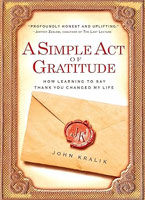 We all say thank you, probably several times a day. We all write those words in emails or via text. Maybe we abbreviate them to “TY” for expediency. But how many of us frequently put ink to paper and write out our gratitude? I was quickly entranced by the author’s desire to write 365 thank you notes in 365 days. Before I started reading this book, I had written over a hundred handwritten thank you notes in 2024. So I was keenly aware of the benefits and burdens of such a task.
We all say thank you, probably several times a day. We all write those words in emails or via text. Maybe we abbreviate them to “TY” for expediency. But how many of us frequently put ink to paper and write out our gratitude? I was quickly entranced by the author’s desire to write 365 thank you notes in 365 days. Before I started reading this book, I had written over a hundred handwritten thank you notes in 2024. So I was keenly aware of the benefits and burdens of such a task.
Reading about John Kralik’s struggles in the legal profession easily sucked me in. Although I am confident that many professions brim with stress and strife, the legal profession is teems with people trying to resolve the stress and strife of others without creating more of its own. It can be a pretty tough way to make a living. Layer onto this some personal misfortunes, and you quickly feel for the author’s rock-bottom situation.
Gratitude as a solution resonates with me. How can we make the most of each moment? By connecting to an overwhelming sense of appreciation for where you are right here and now. Being present. Not being focused on the past or distracted by the future, but being right where you are, fully and completely. The journey of thank-you notes brought the author to a place of gratitude, acceptance, and appreciation.
If you are looking for a quick, heartfelt read, or want to take on the challenge, I encourage you to look into this book.
![]()

Hon. Andrea Totten, County Judge
David Copperfield by Charles Dickens (1850)
I have always loved classic novels. Charlotte Brontë, Jane Austen, and Charles Dickens are among my favorite authors. I have been known to read many of their works several times over. I love a great story set against a backdrop of different times, places, and societal strata. Well-written fiction can serve double duty as an immersive history lesson.
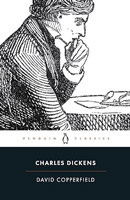 Despite being a longtime fan of Charles Dickens, 2024 was the first time I read David Copperfield. I was interested to learn from the preface that Dickens considered David Copperfield to be nearest to his heart among his novels because the story of David Copperfield most closely reflected Dickens’s own life experiences. David Copperfield is a sweeping story, encompassing the protagonist’s life from infancy well into adulthood, with many interesting characters weaving in and out and crossing paths in unexpected ways. I found myself hesitant to put it down and eager to pick it back up to discover the next twist and turn in Copperfield’s life.
Despite being a longtime fan of Charles Dickens, 2024 was the first time I read David Copperfield. I was interested to learn from the preface that Dickens considered David Copperfield to be nearest to his heart among his novels because the story of David Copperfield most closely reflected Dickens’s own life experiences. David Copperfield is a sweeping story, encompassing the protagonist’s life from infancy well into adulthood, with many interesting characters weaving in and out and crossing paths in unexpected ways. I found myself hesitant to put it down and eager to pick it back up to discover the next twist and turn in Copperfield’s life.
I love Charles Dickens’ subtle satirization of the worst social norms of his day, his dry wit, and his deep understanding of the human psyche. I am continuously struck by the realization that while the world around us has changed dramatically, love, greed, joy, pain, wealth, poverty, and every other human condition is the same now as it was for the wonderfully varied characters imagined by Dickens in the mid 1800s. If you have not read a Charles Dickens novel since you were forced to in high school, I would encourage you to give it another try through the lens of adulthood. I think you will see how much great stuff you missed the first time around.
![]()
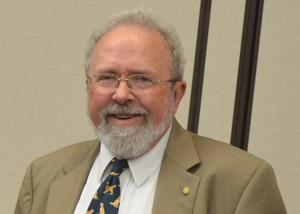
Bob Cuff, lawyer and former Palm Coast City Council member
A History of the World in Twelve Shipwrecks, by David Gibbins (2024)
If nature abhors a vacuum, an empty bookshelf must be a sort of vacuum. In late 2023, a donation cleared two shelves of my collection of books on all things underwater, including several on underwater archeology. Raised on National Geographic and Jacques Cousteau, I thought I had found a fitting home for the books that had inspired my fantasies of underwater treasure hunting and surveyed the newly cleared shelf space with self-righteous satisfaction and more than a bit of sadness. And then the algorithms kicked in and my social media presented me with A History of the World in Twelve Shipwrecks, by David Gibbins. As an ebook, it took up no shelf space, preserving my self righteousness, but re-introduced me to the history of many of the shipwrecks that inspired my original enthusiasm for exploring the underwater world.
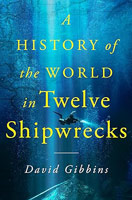 Exactly as the title promises, Gibbins presents the stories of twelve shipwrecks and how the artifacts from their excavations enlighten the times in which they occurred. The wrecks range from unnamed vessels of prehistory through classical Greek, Roman and Viking eras, to more modern ships, from the Mary Rose, famous flagship of King Henry VIII, through the mid-20th century. Although Gibbins does provide some commentary connecting the histories of the various ships, each chapter is essentially a stand alone story of one ship and what it can tell us about its time. This makes the book a good choice for reading in stages. Since I read the ebook version, several chapters filled sleepless hours in the dark and the sleep that followed with renewed dreams of underwater discovery.
Exactly as the title promises, Gibbins presents the stories of twelve shipwrecks and how the artifacts from their excavations enlighten the times in which they occurred. The wrecks range from unnamed vessels of prehistory through classical Greek, Roman and Viking eras, to more modern ships, from the Mary Rose, famous flagship of King Henry VIII, through the mid-20th century. Although Gibbins does provide some commentary connecting the histories of the various ships, each chapter is essentially a stand alone story of one ship and what it can tell us about its time. This makes the book a good choice for reading in stages. Since I read the ebook version, several chapters filled sleepless hours in the dark and the sleep that followed with renewed dreams of underwater discovery.
Gibbins is a scholar (doctorate from Cambridge) and, although the book is intended as popular history, the level of detail presented surrounding some of the shipwrecks may overwhelm the interest of a casual reader. Though several of the wrecks did yield gold and silver, the emphasis is on the other artifacts preserved in the sunken time capsules and how these objects explain an historical period or help bring the lives of the people associated with the wrecks more fully to light.
Especially in the case of later wrecks, such as the Santo Christi di Castello, the Royal Ann Galley–who knew the English Navy of the early 1700s used galleys to suppress piracy and protect the early slave trade?–and the more famous Mary Rose, Gibbins uses his research of the written records about each ship, its crew and the time in which it existed and sank to supplement the artifacts of the ship, making the story revealed by each wreck more interesting for casual readers.
For someone interested in more than conventional history, particularly if that interest is inspired by popular accounts of treasure hunting and underwater adventure, A History of the World in Twelve Shipwrecks is well worth the shelf (and head) space.
![]()

Cari Presley, Principal, Bunnell Elementary
A Tree Grows in Brooklyn, by Betty Smith (1943)
This past year, I revisited my favorite novel, A Tree Grows in Brooklyn, by Betty Smith. I first read this book as a middle school student and it made a profound impact on me. When I interviewed to be principal of Bunnell Elementary School, I was asked to talk about a favorite book, and Smith’s novel, of which I now own a cherished first edition copy, immediately came to mind, inspiring me to read it once more. That second reading gave me a deeper appreciation for the book’s profound themes and Smith’s masterful storytelling.
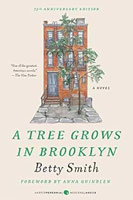 The book holds a special place in my heart because of its timeless portrayal of resilience, hope, and the transformative power of education. At its core, it is the story of Francie Nolan, a young girl growing up in the slums of Brooklyn in the early 20th century, facing poverty and adversity with quiet determination and a hunger to learn. Throughout the story, Francie finds beauty in small things, like reading under the tree in her backyard or finding solace in books borrowed from the library, despite the traumas and barriers around her. Her struggles and triumphs remind me that even in the most difficult circumstances, hope can take root and flourish—just like the tree that grows in the concrete of her neighborhood. This message of perseverance resonates deeply with me and continues to inspire me during challenging times, both personally and professionally.
The book holds a special place in my heart because of its timeless portrayal of resilience, hope, and the transformative power of education. At its core, it is the story of Francie Nolan, a young girl growing up in the slums of Brooklyn in the early 20th century, facing poverty and adversity with quiet determination and a hunger to learn. Throughout the story, Francie finds beauty in small things, like reading under the tree in her backyard or finding solace in books borrowed from the library, despite the traumas and barriers around her. Her struggles and triumphs remind me that even in the most difficult circumstances, hope can take root and flourish—just like the tree that grows in the concrete of her neighborhood. This message of perseverance resonates deeply with me and continues to inspire me during challenging times, both personally and professionally.
Because poverty was a barrier in my own childhood, and is a reality for many of the students and families that I serve, I appreciate Smith’s unflinching honesty about life’s sometimes harsh realities, while still managing to capture the beauty of small, ordinary moments. The novel ultimately highlights the enduring themes of perseverance, hope, and the power of education to create change, showing how one can rise above adversity while cherishing the experiences that shape them. I strive to carry this message with me, recognizing that every small act of kindness, encouragement, or support can help someone grow, much like Francie’s tree, into something stronger and more resilient than imagined.
![]()
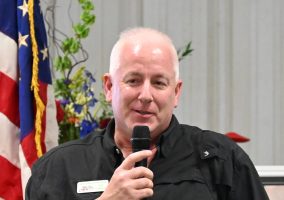
Ed Siarkowicz, President of the Flagler County Historical Society
Where Colors Meet: A Tapestry of Black and White, By the SISters of Seeking Insights for Solutions (2024)
This past year the Flagler County Historical Society has been collaborating with Seeking Insights For Solutions (SIS), a local group of university-educated women dedicated to overcoming inequality and racial barriers. Our collaboration has been focusing on the assembly and telling of all Flagler County history–the good and the bad–so that we can learn and grow from its lessons. At their inception, SIS sat down face to face, Black and White, and told one another their stories and struggles. They overcame generations of misconceptions, they developed relationships, they built trust, and then they went out into the community to make a difference.
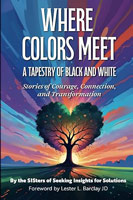 Where Colors Meet: A Tapestry of Black and White is their book, and I was honored when they asked me to read it before it went to print. I had met many of the contributors, but I didn’t know their stories. Now I do, and this has been my favorite book of 2024.
Where Colors Meet: A Tapestry of Black and White is their book, and I was honored when they asked me to read it before it went to print. I had met many of the contributors, but I didn’t know their stories. Now I do, and this has been my favorite book of 2024.
At just over 200 pages, the book is not long, but it is deep, and priceless. It contains the stories of real lives lived and real lives lost, of oppressive situations overcome and, tragically, some that were not.
Travelling through the memories of the authors, my own memories surfaced of witnessing racial, ethnic, and gender inequality. Growing up in the rural suburbs of Long Island and around New York City, there was at times incredible ethnic and racial strife–not only Blacks and Whites but American Blacks and Jamaicans, Jews and Italians, Italians and Irish, Blacks and Italians, Hasidic Jews and Blacks, Germans and Poles. The list goes on and on.
I’ve been in Florida since 1992. As a student of Flagler County history since 2018, when I stepped into a leadership role with the Historical Society, I’ve been privy to both historical and modern-day strife that’s heartbreaking. There have also been stories of heroes who rose above traditions of injustice and did the right thing for another human being.
We can’t change history, we can only change our thoughts and actions and move forward together, valuing one another, learning about and appreciating one another, in order to write a better future. Where Colors Meet: A Tapestry of Black and White is an essential read during a critical moment in humanity’s existence on earth. Right now, today, we must decide how we are going to treat one another.
In Matthew 22:37-40 we are told, “Thou shalt love the Lord thy God with all thy heart, and with all thy soul, and with all thy mind. This is the first and great commandment. And the second is like unto it, Thou shalt love thy neighbor as thyself. On these two commandments hang all the Law and the prophets.”
I pray that the life experiences contained in this book open your eyes, ears, mind, and heart to treat humanity with the love, respect, mercy, and compassion that you would want for yourself.
![]()

Joe Saloom, Assistant Library Director, Flagler County Public Library
The Little Liar, by Mitch Albom (2023)
One of the best books I read in 2024 was The Little Liar, by Mitch Albom. It’s a fictional story that starts out in the coastal Jewish town of Salonica in Greece as it’s invaded by Nazi’s during World War II. The main character is a young boy who refused to tell lies until he was tricked into lying to his entire town by a German officer. From that point on he did nothing but lie. The story follows the young boy and his brother, a female classmate of theirs, and the German officer as they survive the war.
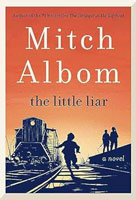 The book is written as a parable of truth and empathy. The narrator is “truth,” and the focus of the story is on the main characters’ interactions, the consequences of those interactions, and how those consequences affected them throughout their lives. It personally resonated with me as I feel honesty and empathy are two of the most important virtues we should incorporate into our lives. I think this book does a great job at promoting its lessons by appealing to every type of reader through elements of mystery, action, adventure, romance, and history throughout.
The book is written as a parable of truth and empathy. The narrator is “truth,” and the focus of the story is on the main characters’ interactions, the consequences of those interactions, and how those consequences affected them throughout their lives. It personally resonated with me as I feel honesty and empathy are two of the most important virtues we should incorporate into our lives. I think this book does a great job at promoting its lessons by appealing to every type of reader through elements of mystery, action, adventure, romance, and history throughout.
I’d never read a book by Mitch Albom before, even though he wrote the bestselling The Five People You Meet in Heaven, but it was this year’s Flagler Reads Together chosen book, so I was looking forward to reading it. Flagler Reads Together is an annual library program that highlights a popular book and offers themed programs and discussions. I must admit that this isn’t the usual genre I read – I’m more of a Sci-fi/Fantasy reader – but Mitch Albom’s style of writing and storytelling led to a book that I just couldn’t put down. It’s good to read something different, and a book like this is the reason why.
![]()

Jim Tager, Educator, Writer, Former Flagler County Superintendent
The Other Wes Moore One Name, Two Fates” by Wes Moore (2011)
Currently I am reading The Other Wes Moore: One Name, Two Fates, by Wes Moore. Since retiring in July of 2024 I have been reading a book a month , alternating between something leadership/educational-related or a solid fictional choice (truth be told, I’ve read every Jon Grisham and Stephen King book published). The Other Wes Moore reminds me of some of the students I have encountered throughout my 42 years as an educator.
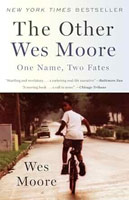 The book tells the graphic stories of two boys, both named Wes Moore, born the same year within blocks of each other in Baltimore. Both young men grew up fatherless, hung out on the streets, and had trouble with the police. One Wes grew up to become a Rhodes Scholar, decorated veteran, White House Fellow and business leader. The other Wes ended up becoming a convicted murderer serving a life sentence. The Other Wes Moore is a heart-wrenching story of a generation of boys navigating their way in a world fraught with struggles that appear unsurvivable.
The book tells the graphic stories of two boys, both named Wes Moore, born the same year within blocks of each other in Baltimore. Both young men grew up fatherless, hung out on the streets, and had trouble with the police. One Wes grew up to become a Rhodes Scholar, decorated veteran, White House Fellow and business leader. The other Wes ended up becoming a convicted murderer serving a life sentence. The Other Wes Moore is a heart-wrenching story of a generation of boys navigating their way in a world fraught with struggles that appear unsurvivable.
In the beginning of the book Wes from the outside world interviews “The Other Wes” inside the Jessup Correctional Institute in Maryland, posing a question about his father’s impact and how that may have influenced the trajectory of his life. “The Other Wes” who currently practices the Islamic Faith in prison responds: “Your father wasn’t there because he couldn’t be, my father wasn’t there because he chose not to be. We’re going to mourn their differences in different ways.”
The book details many interviews which, while tragic, make me lean into each chapter to better understand a world through the eyes of two Wes Moores during their childhood years and formative years. Reading first-hand testimony makes this book a must read.
When moving home from Bangor, Maine, this summer, we drove through the Bronx in New York, one of the cities that Wes lived in as a young boy: at the time it was a place where gunfire was frequent, gangs were abundant and territorial, and crack cocaine was epidemic. While driving through the Bronx this summer we were gridlocked in traffic for two hours. We saw gangs of people congregating on the streets and noticing many sets of blank, zombie-like eyes. We couldn’t wait for the traffic to flow. Reading the book now, it’s unimaginable to learn what the two Wes Moores dealt with on a daily basis. The book is hard to read dry-eyed due to the vivid commentary. Yet it provides insight into humanity at its best and worst.
As a career educator, the book opens my eyes to the fact that you never know what circumstances students come from. Of greater importance, however, is that this book poignantly demonstrates the need for all students to have a mentor or family member who believes in them.
![]()
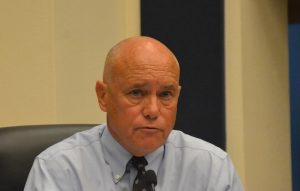
Donald O’Brien, Insurance Executive and former Flagler County Commissioner and Insurance Executive
The Extinction of Experience: Being Human in a Disembodied World, by Christine Rosen (2024).
I do not consider myself to be a Luddite. In fact I would describe myself as an “early adopter.” Starting with the Apple IIc, I am always eager to buy the newest computer, iPhone, iPad, Kindle, and wearable. However, for me, social media, online communities, and a virtual existence have been anathema.
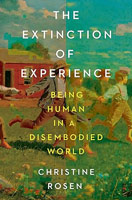 My observation and personal experience is that social media and the associated virtual world have almost no redeeming qualities. It has normalized the worst of human behavior, is a contributing cause of social ills, and is a net negative for society. Maybe… I am a Luddite!
My observation and personal experience is that social media and the associated virtual world have almost no redeeming qualities. It has normalized the worst of human behavior, is a contributing cause of social ills, and is a net negative for society. Maybe… I am a Luddite!
Given my dim view of social media, when I read about a book written by Christine Rosen of the American Enterprise Institute titled The Extinction of Experience: Being Human in a Disembodied World, I was motivated to read it. I assumed it would confirm my bias.
Rosen offers an argument that our reliance on technology is negatively impacting “the richness of human experience, leaving us with a hollow sense of existence.” She explores the ways technology, from social media to virtual reality, shapes our perceptions and interactions. She points out that the extensive use of social media has social and psychological consequences manifested in loss of connection, erosion of attention spans, and a decline in critical thinking. Rosen supports her arguments with empirical evidence by referencing studies, statistics, and research findings.
I recommend this book for readers who have teenage children and anyone who wants to explore their relationship with technology and their digital habits and how it may impact their wellness.
![]()

Amelia Fulmer, Director of Fitzgerald Performing Arts Center at Flagler Auditorium
Act Like a Leader, Think Like a Leader, by Herminia Ibarra (2015)
Herminia Ibarra’s Act Like a Leader, Think Like a Leader has been my favorite read of the year because it has reshaped how I view leadership, personal growth, and the importance of stepping beyond comfort zones—especially in my role as an arts advocate running a unique nonprofit.
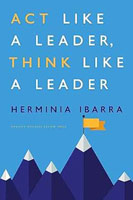 One of the book’s central themes is that “the best way to figure out how to lead differently is to change what you do.” This resonates with me because I often interact with the same people in familiar settings—whether it’s ticket buyers, board members, sponsors, or families I encountered from years of teaching. While these relationships are comfortable and valuable, they don’t always push me to grow or expose me to new ideas. Ibarra’s emphasis on experimentation and taking calculated risks has encouraged me to seek out new people that I don’t really know, even when it feels uncomfortable or uncertain.
One of the book’s central themes is that “the best way to figure out how to lead differently is to change what you do.” This resonates with me because I often interact with the same people in familiar settings—whether it’s ticket buyers, board members, sponsors, or families I encountered from years of teaching. While these relationships are comfortable and valuable, they don’t always push me to grow or expose me to new ideas. Ibarra’s emphasis on experimentation and taking calculated risks has encouraged me to seek out new people that I don’t really know, even when it feels uncomfortable or uncertain.
Another idea that struck a chord is her concept that “outsight, not just insight, is what sparks change.” As a nonprofit leader, I’m constantly strategizing how to further the organization’s mission. But Ibarra’s perspective has taught me that personal and professional growth often comes from learning through external interactions—meeting new people, exploring unfamiliar opportunities, and inviting fresh perspectives. This has inspired me to intentionally expand my circle beyond the arts and education community I know so well, to connect with leaders in other sectors and explore how their insights could benefit my work.
Her advice on networking also aligns closely with this. “If you only network when you need something, it’s already too late” is a powerful reminder that building relationships is a proactive process. By cultivating a diverse and strategic network, we gain resources for our organizations and challenge ourselves to grow in new directions. As Ibarra notes, “A good network pushes you out of your comfort zone and exposes you to different perspectives.” This has encouraged me to step into spaces where I don’t know anyone, fostering relationships with people whose experiences and expertise differ from mine. It’s not always easy, but it has helped me spark fresh ideas and collaborations that I wouldn’t have found otherwise.
In short, Ibarra’s book has given me actionable strategies to think and act differently as a leader—to take risks, embrace discomfort, and expand my worldview. It’s a timely and transformative read for anyone looking to grow personally and professionally, and it has profoundly impacted how I approach my role as the auditorium director.
![]()
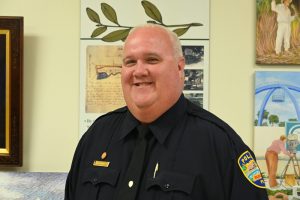
David Brannon, Bunnell Police Chief
There’s No Plan B for Your A Game, by Bo Eason (2019)
My favorite read for 2024 came from a short list of books recommended to me by a fellow police chief that helped to shape their perspective and resulted in a successful career. There’s No Plan B for Your A Game by Bo Eason was on the list, and the title drew my interest.
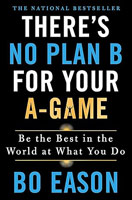 The book is about going all-in on your biggest dreams and not settling for anything less than being the best. Achieving excellence is not an accident. It takes a deliberate mindset to focus on all that is required to not simply be successful, but to be the best in whatever you set your mind to accomplish. Eason shared his own story of how he went from being an underdog in sports to playing in the NFL for the Houston Oilers in the 1980s, then becoming a successful playwright and speaker. The main theme of the book is to identify one goal with great meaning to you and commit to it fully—no backup plans or safety nets. The book is packed with personal stories and advice on how to build the mindset and habits you need to succeed in anything you want to do.
The book is about going all-in on your biggest dreams and not settling for anything less than being the best. Achieving excellence is not an accident. It takes a deliberate mindset to focus on all that is required to not simply be successful, but to be the best in whatever you set your mind to accomplish. Eason shared his own story of how he went from being an underdog in sports to playing in the NFL for the Houston Oilers in the 1980s, then becoming a successful playwright and speaker. The main theme of the book is to identify one goal with great meaning to you and commit to it fully—no backup plans or safety nets. The book is packed with personal stories and advice on how to build the mindset and habits you need to succeed in anything you want to do.
One Eason’s main points is the importance of practice and consistency. He explains that success isn’t about talent or luck—it’s about showing up and putting in the work every single day. For example, he shares how he trained harder than anyone else to make it to the NFL and how this same level of effort applied to any goal. It is not about quick wins, but about playing the long game and staying focused. The book encourages the reader to think big, be persistent, and never give up when things get tough.
What really stuck with me is how practical and motivating Eason’s message is. He gives the reader tools to help stay focused, like visualizing success and surrounding yourself with people who push you to be better. It is not only about achieving career goals. It is also about becoming the best version of yourself. The main message I took away is if you want to achieve something great, you cannot have a Plan B—you must fully commit to your “A Game” and trust the hard work will pay off.
It’s a great read if you need a push to go after something you really want.
![]()

Monica Campana, Educator and Retired Librarian (Indian Trails Middle)
The One in a Million Boy, by Monica Wood (2017)
My day begins reading Letters from an American by Heather Cox Richardson so it follows that the most important book I read in 2024 was Democracy Awakening. In retrospect, not enough people read it.
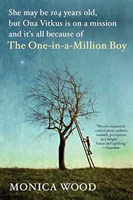 My favorite book however was The One in a Million Boy by Monica Wood. You don’t spend 30 years working with kids and not appreciate a precocious, bright and curiously loveable kid like this 11 year old boy scout. We are never given his name–he is just the boy. A boy who is bullied at school, misunderstood by his own dad, and loved by his mom. But most of the world ignores him. A master of research and infatuated by the Guinness book, he makes lists of 10 records daily which are listed at the end of each chapter.
My favorite book however was The One in a Million Boy by Monica Wood. You don’t spend 30 years working with kids and not appreciate a precocious, bright and curiously loveable kid like this 11 year old boy scout. We are never given his name–he is just the boy. A boy who is bullied at school, misunderstood by his own dad, and loved by his mom. But most of the world ignores him. A master of research and infatuated by the Guinness book, he makes lists of 10 records daily which are listed at the end of each chapter.
Meet 104 year old Ona Vitkus, a crotchety old woman who fires every boy scout who is sent to take out her trash and fill her bird feeders–except this boy. He is meticulous, prompt, hard working and it turns out fascinating to talk to. When he presents her with a school project where he has been assigned to interview someone who lived through World War II, she begrudgingly obliges. But as Ona states, “The story of your life never starts at the beginning. Don’t they teach you anything at school?” Hilarious and heart wrenching, confusingly clear, succinctly wordy, the conversations ensue with the hormonal fluctuation of a middle schooler and a cranky old lady.
Ona is heartbroken when the boy is a no-show for his last Saturday with her. A cast of characters evolve and end up making the connections and find the purpose every human searches for in life. Wood beautifully describes the boy’s obsessive daily bike ride at dawn as “Then ten, and ten again, chiming from concealed spots above and between and around the houses and garages and parked cars and telephone poles and the light urges into the astonishing hour, each chime pecking a pinhole in the sheeted dark until the last layers shred completely, and the light pours in and in.”
May this little gem of a book help you find the light in every day. May you find hopefulness, joy, purpose and connection like the characters in this book. Keep tissues handy though. You will need them.
![]()
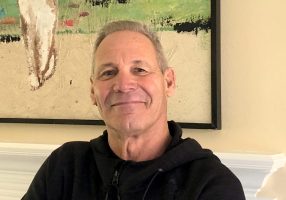
Caesar Campana, Novelist, Educator, Retired English Teacher and Football Coach (FPC)
The Year of the Death of Ricardo Reis, by José Saramago (1991)
The Year of the Death of Ricardo Reis, by José Saramago was my favorite book of 2024. I read this novel because I wanted to learn about Portugal.
I often read fiction that takes place in the city I plan to visit. This is a fun way to understand a new place without being bogged down by shallow travel promotions and Rick Steves Disneyish pablum. This research method is how I found The Year of the Death of Ricardo Reis. Last November, before my wife Monica and I traveled to Lisbon, I googled “great fiction about Portugal.” José Saramago’s books were the first to come up on my search. I will read many more of his books.
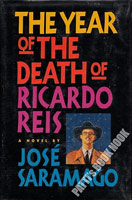 First, let me warn you: The Year of the Death of Ricardo Reis is a subtle, strange story that will never appear on Oprah’s Book Club list—the type of books filled with sensational titillating narratives penned by popstar/prolific (repetitive?) Pattersons, Rowlings and Browns who roll out movie-ready stories about spies, murders and sexy people doing decadent things, which millions of devout followers devour, digest, and drunkenly discuss at their monthly book club gatherings.
First, let me warn you: The Year of the Death of Ricardo Reis is a subtle, strange story that will never appear on Oprah’s Book Club list—the type of books filled with sensational titillating narratives penned by popstar/prolific (repetitive?) Pattersons, Rowlings and Browns who roll out movie-ready stories about spies, murders and sexy people doing decadent things, which millions of devout followers devour, digest, and drunkenly discuss at their monthly book club gatherings.
Oprah Book Club fans will hate The Year of the Death of Ricardo Reis. They won’t get past the first chapter.
Side note: If you like the stories written by Gabriel Garcia Márquez, read my 2024 favorite book.
Saramago’s novel begins in 1936 Portugal as Doctor Ricardo Reis returns to his home country to honor his recently deceased friend, poet Fernando Pessoa. While Reis was exiled in Brazil for 16 years, Europe has become a tinderbox with Germany’s fascist leader calling for the persecution of Jews and other “enemies of the state.” More personal to Ricardo, however, his home country, Portugal, is now ruled by a dictator.
As he arrives, he has an ominous feeling for his future. He is old and there are warships in the Lisbon harbor.
The Year of the Death of Ricardo Reis is a heavy, slow read, 358 pages long formed from 500-word paragraphs stitched together with rolling 60-word sentences. The plot can seem bland, the descriptions boring. But Saramago’s narrative is like a low Gregorian chant humming on and on until you realize the rhythm is working to motivate you and the lyrics are cantos for happiness.
As the title boldly proclaims, Ricardo Reis’s final journey begins as he steps away from the Tagus River and onto the shore of his homeland, propelling him through the streets of Lisbon (and eventually to his unavoidable grave). As Reis wanders the tilted, tiled, narrow streets of Lisbon he ponders the definitions of happiness, despair, life, death, love, loneliness, and unremarkably, what he should have for dinner. Although tired and confused for most of his nostalgic homecoming, he is comforted by the chime of the thousand-year-old church bells, the conversations of his fellow countrymen, and the warm body of the hotel chambermaid. It doesn’t take long for our protagonist to understand that his home city is where he belongs—where he should spend the rest of his life. This is where he can face his mortality.
But there is a deeper transcendental theme to the protagonist’s mundane routine. He is a medical doctor who also writes poetry—a Renaissance Man, so to speak. Poetic lines, rhyming and romantic words balance his professional livelihood that is immersed in blood, stitches, and broken bones. It’s important to note that his best friend was Portugal’s greatest poet, Fernando Pessoa. With Dr. Reis, we see a man who understands the harsh reality of sickness and death as well as a man who admires the significance and beauty of poetry (especially the poetry of Portugal).
Side note part 2: Ricardo’s mystical odyssey is flipped upside down (at least for me) when his famous friend, Fernando Pessoa, still wearing the suit he was buried in, visits Reis at his hotel.
As a reader, following Ricardo’s thoughts, digesting his stream of consciousness descriptions of the streets, cathedrals, and statues, is like having a tour guide who is also your priest, psychiatrist, physician, and mortician. Uniquely, Saramago’s point of view often slips from a 3rd person POV to a 1st person POV. This writing style was initially awkward for me to follow until I realized the author was showing this story from two opposing sides, debating the issue of death. It’s like God is giving his omniscient perspective about a little bug scurrying around a fish tank while Ricardo, the mortal, raises his fist at the heavens yelling, “I’m not afraid to die.”
Spoiler Alert: É Pessoa quem, no final, leva Ricardo ao cemitério. (For the translation, click here.)
![]()
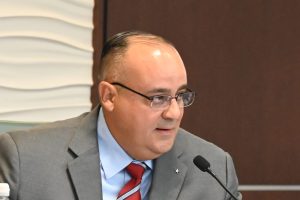
Charles Gambaro Jr., Palm Coast City Council Member, President of Spearhead Strategies, Brigadier General, U.S. Army Reserve
At War with Ourselves: My Tour of Duty in the Trump White House, By Lieutenant General (Retired) H.R. McMaster (2024)
H.R. McMaster served as President Donald Trump’s second National Security Advisor. General McMaster has an impressive military career both on and off the battlefield and is known for challenging the status quo in order to drive positive change. As a young Major, McMaster wrote a book titled Dereliction of Duty, which chronicled the reasons and the lies that led to our nation’s deeper involvement in the Vietnam War. This honest account of our involvement in Vietnam almost ended General McMaster’s military career because he questioned the assumptions and recommendations of our senior military leaders to the President of the United States.
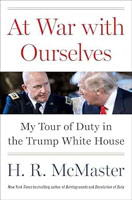 McMaster was appointed by President Trump on February 20, 2017 to serve as his National Security Advisor. As a Senior Army Officer serving in a very political position, McMaster took great care not to fall into the same traps that led to the poor decision-making processes during the Vietnam War. However, McMaster did not anticipate the challenges of running the policy development process at the National Security Council when the federal departments and agencies had their own agendas, the barrage of constant attacks from the media and members of Congress, and learning how to adjust to the president’s leadership style. In the end, McMaster chose to be the consummate “honest broker” for the American People.
McMaster was appointed by President Trump on February 20, 2017 to serve as his National Security Advisor. As a Senior Army Officer serving in a very political position, McMaster took great care not to fall into the same traps that led to the poor decision-making processes during the Vietnam War. However, McMaster did not anticipate the challenges of running the policy development process at the National Security Council when the federal departments and agencies had their own agendas, the barrage of constant attacks from the media and members of Congress, and learning how to adjust to the president’s leadership style. In the end, McMaster chose to be the consummate “honest broker” for the American People.
As I reflect on my tour at the National Security Council, I experienced many of the challenges that General McMaster shares in his book. Our biggest mandate was to provide the President of the United States with the best policy options and to carry out our duty to serve as the “honest broker.” There is a direct application of the lessons learned by McMaster to all levels of public service. This is especially true for those of us who have taken an oath to protect and serve the citizens of our community. Serving as an “honest broker” is not always easy, but it is certainly something we should always strive for in an effort to better serve our community. I recommend the book.
![]()
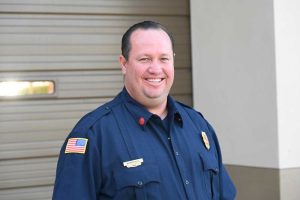
Kyle Berryhill, Palm Coast Fire Chief
East of Eden, by John Steinbeck (1952)
Last year when I saw this piece I thought it was the coolest, and when asked to contribute to this year’s edition a few weeks ago I took the assignment incredibly seriously. Why? Because a love for reading has been one of the greatest and best influences in my life.
 Although I thoroughly enjoyed some “wonky” books like Grit (Angela Duckworth) and Mindset (Carol Dweck), in 2024 I was once again drawn to some of my all-time favorites. Am I the only one who begins a familiar book thinking they will just read a passage and soon after are immersed in the story?
Although I thoroughly enjoyed some “wonky” books like Grit (Angela Duckworth) and Mindset (Carol Dweck), in 2024 I was once again drawn to some of my all-time favorites. Am I the only one who begins a familiar book thinking they will just read a passage and soon after are immersed in the story?
My choice for my favorite book of 2024 is John Steinbeck’s East of Eden. It tells the story of two American families (one of which was Steinbeck’s actual family). Nothing interests me more than families, what makes them happy, what breaks their hearts, and how they respond to both great joy and great sorrow. This story is the allegorical progeny of the Biblical story of Cain and Abel. But Steinbeck doesn’t judge (well… except for Cathy) and moves the story towards a concept of the human ability to make the next choice.
I can clearly see how this book tracks to life in the fire service: we consistently respond to situations where things have happened that we can no longer control, but we can often make a big impact on what happens next. My friend Bradd [Clark, Palm Coast’s deputy fire chief] says that the windshield is bigger than the rearview mirror for a reason. Steinbeck says that the Almighty’s message to man through Cain is “timshel” or “thou mayest.” Either way – I love the idea and the hope that we can draw from the concept that we can make a difference in both our own lives and the lives of others.
![]()

Kristin Bozeman, Principal, Matanzas High School (2024 Principal of the Year)
Tress and the Emerald Sea, by Brandon Sanderson (2023)
The best book I read all year was Tress and the Emerald Sea, by Brandon Sanderson. While I’m sure as an educational leader I should suggest the latest text on education or leadership, I personally enjoy reading to relax and let my imagination roam, so when I was asked if I would like to share a book, I thought of this one immediately.
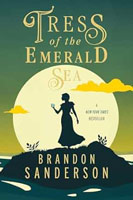 Of course as the Principal of Matanzas High School, I loved that this book is a fun pirate adventure, but it’s also warm and fuzzy and a pleasure to read. Tress and the Emerald Sea tells the story of Tress, a young woman from an isolated island, which she never dreamt of leaving, who embarks on a bold pirate adventure to save her missing best friend. I loved this book the most because of the growth of the main character, who is unfailingly kind, but also learns to be bold and brave.
Of course as the Principal of Matanzas High School, I loved that this book is a fun pirate adventure, but it’s also warm and fuzzy and a pleasure to read. Tress and the Emerald Sea tells the story of Tress, a young woman from an isolated island, which she never dreamt of leaving, who embarks on a bold pirate adventure to save her missing best friend. I loved this book the most because of the growth of the main character, who is unfailingly kind, but also learns to be bold and brave.
I think that just about anyone would enjoy this book, which is set in a fantastical universe where pirate ships sail on oceans made of poisonous spores instead of water. If you aren’t a fantasy reader, I can hear you tuning this review out, but I would advise you to give it a try. Don’t worry, you aren’t getting sucked into a long drawn out series with a million characters and creatures. This is a stand-alone book that is a quick read and that I truly think most folks would enjoy.
From the Captain of “The Ship” Matanzas High School, Happy Reading!
![]()
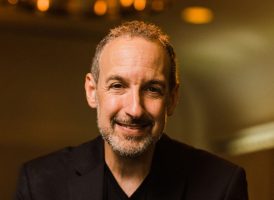
Jay Scherr, Business Coach and Consultant, Podcast and Radio Show Host, President of Flagler Tiger Bay Club
Unlearning Silence by Elaine Lin Hering (2024)
It was not easy narrowing down my list to just one favorite book, but I chose Unlearning Silence by Elaine Lin Hering. This book spoke to me on several fronts. It offers an eye-opening perspective on the power of finding and using one’s voice. In a world where silence is often equated with compliance or politeness, this book challenges those deeply ingrained norms and encourages us to break free from the conditioning that holds us back.
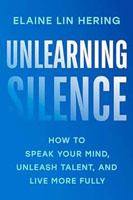 For me, it illuminated how silence, whether born of fear, habit, or societal expectations, can limit personal growth and stifle authentic connection. This book not only helped me reflect on my own tendencies but also inspired me to cultivate environments where others feel safe and empowered to share their perspectives.
For me, it illuminated how silence, whether born of fear, habit, or societal expectations, can limit personal growth and stifle authentic connection. This book not only helped me reflect on my own tendencies but also inspired me to cultivate environments where others feel safe and empowered to share their perspectives.
Ultimately, Unlearning Silence reminded me that finding our voice isn’t just about speaking—it’s about reclaiming our agency, strengthening relationships, and unlocking our full potential.
As a side note, I had the privilege of interviewing Elaine Lin Hering on Episode 228 of my podcast, Business Minds Coffee Chat. The conversation deepened my appreciation for her insights and the transformative power of this book.
![]()
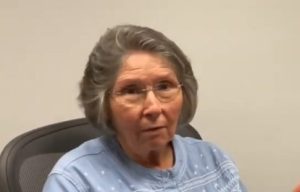
Brynn Newton, Retired Attorney, Sierra Club Executive Committee Member
Good Day Sunshine State: How the Beatles Rocked Florida by Bob Kealing (2023)
As a diehard Beatlemaniac, I expected this book to take me on a stroll down Memory Lane, and it did. I relived a lot of the experiences of 1964 but also learned a lot, about the Beatles and about my state of Florida.
 Kealing, a journalist, did some amazing and thorough research and placed the phenomenon of John, Paul, George, and Ringo beautifully in geographical and historical context. I well remember, as he described, what an antidote the Beatles were in the bleak aftermath of President Kennedy’s assassination, just as I well remember November 22nd itself, when a kindly phys. ed. teacher let me sit in her office by myself while the rest of my Palatka middle school classmates celebrated.
Kealing, a journalist, did some amazing and thorough research and placed the phenomenon of John, Paul, George, and Ringo beautifully in geographical and historical context. I well remember, as he described, what an antidote the Beatles were in the bleak aftermath of President Kennedy’s assassination, just as I well remember November 22nd itself, when a kindly phys. ed. teacher let me sit in her office by myself while the rest of my Palatka middle school classmates celebrated.
It was a lot of fun retracing the paths of the Beatles on both of their Florida visits and appreciating anew how their views and attitudes both intersected and collided with the place they were visiting and the times they were about to help change. (Their insistence that their concert at the Gator Bowl in Jacksonville be integrated could have been a deal breaker.) If you can’t find a copy of If It Takes All Summer, this book paints a good picture of what one of my other heroes, its author Dan Warren, accomplished when St. Augustine erupted because Martin Luther King, Jr., had come to town.
The explosive mania that swept the country, the musical inspiration that would lead some Florida kids to become national rock stars, the racial unrest, and the looming escalation of the Vietnam War are all beautifully interwoven–and educational. Before I opened the book I had already awarded Kealing the prize of Best Title but it was packed with lots to learn, including the origin of some of the lyrics of Track 7, Side Two of Abbey Road.
![]()
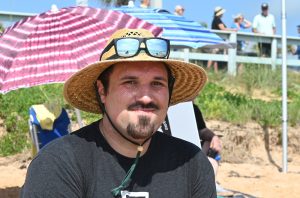
Chris Gollon, Managing Editor, AskFlagler
Eastbound, by Maylis de Kerangal, tr. Jessica Moore (2023)
I would be remiss to not mention how much I gained from reading the late Matthew Perry’s memoir on the harrows of addiction, but the most impactful book I read in 2024 was Eastbound, written by Maylis de Kerangal and translated from French by Jessica Moore. The book tells the story of a young Russian conscript on a train to mandatory military service, a fate from which he desperately wants to escape. His path intersects–fatefully so–with an upper-class French woman also fleeing a past life.
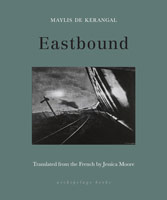 Not since Margaret Atwood’s Handmaid’s Tale have I read a book which so eloquently explored as many philosophical concepts as Eastbound does. The obvious is the ethics of desertion. Furthermore, while Ukraine is never mentioned (the story predates Putin’s 2022 invasion), the reader is offered a glimpse into what it may be like for real Russian soldiers thrust into service against their will.
Not since Margaret Atwood’s Handmaid’s Tale have I read a book which so eloquently explored as many philosophical concepts as Eastbound does. The obvious is the ethics of desertion. Furthermore, while Ukraine is never mentioned (the story predates Putin’s 2022 invasion), the reader is offered a glimpse into what it may be like for real Russian soldiers thrust into service against their will.
Another theme is more subtle: the soldier begins his journey in the conscripts’ passenger car, a bleak chamber of misery which conveys claustrophobia with shocking effectiveness. When he encounters the French woman, she’s riding a luxury private cabin. With a language barrier preventing direct dialogue, the comfortable first-worlder grapples with whether to grant asylum to a young foreigner whose very survival hinges desperately on her compassion. Sounds familiar yet?
All this to say, Eastbound meditates intently on instinct, motivation, and the human element of geopolitics. But what truly elevates the works is the rush of vicariously experiencing entire worlds within the small train cars. To trek across the largest country on earth having never left one bleak corner of its society is to ride a ship into the cosmos. A glimmering lake out the window may well be a scarlet nebula off the shoulder of Orion. A peaceful countryside, the hypnotic atmosphere of Jupiter. To be amongst every walk of life all in equal awe of the alien beauty of the Trans-Siberian Railroad is to be, in the truest sense, a member of the human race. Eastbound is nothing if not fully immersive into that phenomenon.
![]()

Pierre Tristam, Reporter
Orbital, by Samantha Harvey (2023)
Samantha Harvey’s Orbital reminds us that the best novels since Tristram Shandy and its bleaker cousin, Rousseau’s Confessions–one of the best-written, most ridiculous fictions of the 18th century–are impossible to define, especially as novels. The more impossible, the more interesting the novel. The most interesting this year for me, as it turned out. Discombobulating from the first page, Orbital is the story of 16 sunrises and sunsets in a single day. Clearly, we’re not in Kansas anymore. We’re not even on earth, though this is no SciFi fantasy. It’s more like Marcus Aurelius meets Rachel Carson along Cormac McCarthy’s Road 250 miles above Earth, at 17,500 miles per hour. Cue the Philip Glass soundtrack for full effect.
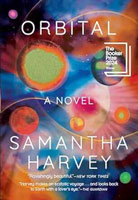 This short, sublime little book where “the whip-crack of morning arrives every ninety minutes” is the story of six astronauts’ 24 earthly hours aboard the International Space Station. Harvey is no astronaut. Bu she seems to have researched her subject with the obsession of Flaubert researching The Temptation of St. Anthony, becoming more astronaut than the astronauts and taking us with her, giving us “the puffy cheeks of the gravity-less,” making us see “the flexing, morphing green and red of the auroras,” making us feel the crushing loneliness and emptiness of space, of Earth’s impossible nowhere, “where the darkness is endless and ferocious,” even as we discover that “companionship is our consolation for being trivial.”
This short, sublime little book where “the whip-crack of morning arrives every ninety minutes” is the story of six astronauts’ 24 earthly hours aboard the International Space Station. Harvey is no astronaut. Bu she seems to have researched her subject with the obsession of Flaubert researching The Temptation of St. Anthony, becoming more astronaut than the astronauts and taking us with her, giving us “the puffy cheeks of the gravity-less,” making us see “the flexing, morphing green and red of the auroras,” making us feel the crushing loneliness and emptiness of space, of Earth’s impossible nowhere, “where the darkness is endless and ferocious,” even as we discover that “companionship is our consolation for being trivial.”
Flaubert’s St. Anthony is unreadable. Harvey’s Orbital is hypnotic, whether it is explaining the step-by-step packaging of human waste from the station–we’re talking excrement in all its excrescence–or taking the measure of the waste-makers in all their glorious irrelevance: “And in time we come to see that not only are we on the sidelines of the universe but that it’s of a universe of sidelines, that there is no centre, just a giddy mass of waltzing things.”
Each astronaut is a life encapsulated between sunrises. Chie, “a methodical and fearless and crystalline mind,” keeps lists, talks to her experimental mice, mourns their brief, sacrificial lives (as if ours are much different), and learns that her mother, who survived the Hiroshima bombing as an infant, has died. Pietro is the veteran of 400-some days in space. Nell the atheist lit candles on the birthdays of the Challenger’s victims for three years after its disintegration. Roman connects with a ham operator in Vancouver who asks: what’s the point? Anton no longer loves his wife and has a lump on his neck he keeps secret, because he doesn’t want to be shipped out. Shaun, a believer, misses his wife, whose postcard of “Las Meninas,” the beguiling painting by Velásquez, is its own fling into the wonders of the unknowable as Harvey returns again and again–sunset, sunrise–to that 17th century masterpiece as a mirror to the subverted perspectives of the astronauts as “day by day the tethers of their lives have broken one after the other and everything they are now is a new invention.”
But the main character, the hero of Orbital–tragic, beloved, alone for all her trillions of children–is Earth, the blue dot, “the face of an exulted lover.”
“They were warned about what would happen with repeated exposure to this seamless earth,” Harvey writes. “You will see, they were told, its fullness, its absence of borders except those between land and sea. You’ll see no countries, just a rolling indivisible globe which knows no possibility of separation, let alone war. And you’ll feel yourself pulled in two directions at once. Exhilaration, anxiety, rapture, depression, tenderness, anger, hope, despair. Because of course you know that war abounds and that borders are something that people will kill and die for. While up here there might be the small and distant rucking of land that tells of a mountain range and there might be a vein that suggests a great river, but that’s where it ends. There’s no wall or barrier – no tribes, no war or corruption or particular cause for fear.”
OK, so it gets a tad preachy, even sentimental. But who isn’t? Who can afford not to be, when–as Harvey with stylistic grace manages to remove the cliche from Mother Earth–she’s all we’ve got?
![]()
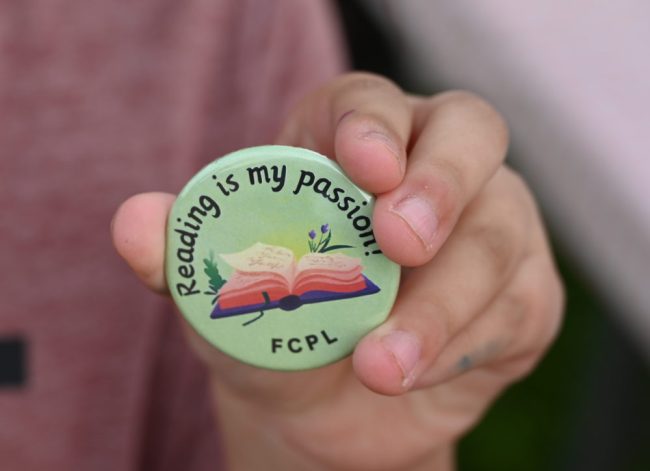





























Atwp says
Thank you for the list of favorite books that were read. Have not read most of the books but planning to read the Wes Moore Book. I wonder how many of the authors are My Color. Probably none to very few. The Florida Republicans will probably continue to take African American Books off of the shelves state wide.
TR says
Happy New Year Atwp, It’s be awhile and I see you’re still making racist comments. It’s a new year so maybe things will change with you. I haven’t been on here a lot because of one reason is all your racist comments. I guess it’s okay for the people of “Your color” to fight to have all the white statues removed with history in the USA which is across the entire country. So don’t make it sounds as if “Your Color ” people are the ones removing history when they are also doing it.
Hope you have a good year, I’m gone again for awhile.
Pierre Tristam says
While I don’t disagree that on occasion Atwp’s Oda May ends up channeling more Farrakhan than shapely pottery, to characterize Atwp’s comment here as “racist” is ridiculous: what he refers to is accurate. To do so in the terms TR chose is itself–with its sneering quote marks, its plantation-era condescension, its blatant falsehoods about statues (Confederate white supremacists who wanted to keep raping their slaves aside)–not quite not racist. Atwp is astute to note the dearth of writers of color, less among the chosen books than the chosen writers. I take responsibility for the latter, though our contributors made up for it in their reviews. We’ll be more colorful next year.
Atwp says
Happy N/Y to you too,TR. Are my comments wrong? Did we try to have all white statues removed or the statues of people who oppressed my and other people of color.
Endless dark money says
Isn’t reading woke? It may cause you to think and see the corruption all around.
Brynn Newton says
For anyone sharing our Editor’s former reluctance to read Dickens, let me recommend Norrie Epstein’s “The Friendly Dickens.” She’s better known for “The Friendly Shakespeare” (which should be required reading for youngsters) but Dickens is Epstein’s favorite writer.
I appreciate Judge Totten’s recommendation of “David Copperfield.” I haven’t read it (yet) but like many others of a certain upbringing, I know the first few lines well and will always hear them being read in Melanie Wilkes’ Southern accent.
What Else Is New says
Thank you, Pierre. Once again, we see avid readers extolling the virtue of reading! I’ve read some of these offerings and intend to read a few others. Great project! One’s ambition is to live long enough to read all those books on one’s list!
Pierre Tristam says
And you know well that some of the books on my recurring list are from your library: every time I pick up Robert Fisk’s Great War for Civilization, Taylor’s signature graces—blesses—the reading session, grim though Fisk (and my miserable Middle East) tend to be.
Sherry says
I’m thinking that in addition to Orwell’s masterpiece 1984, it would be enlightening for those who have not read Ray Bradbury’s Fahrenheit 451 to do so. In it you what just may see a preview of the future of books in Florida . . . and, perhaps the entire country. After all, books educate, they activate the mind. Who needs that barrier to fascism, right?